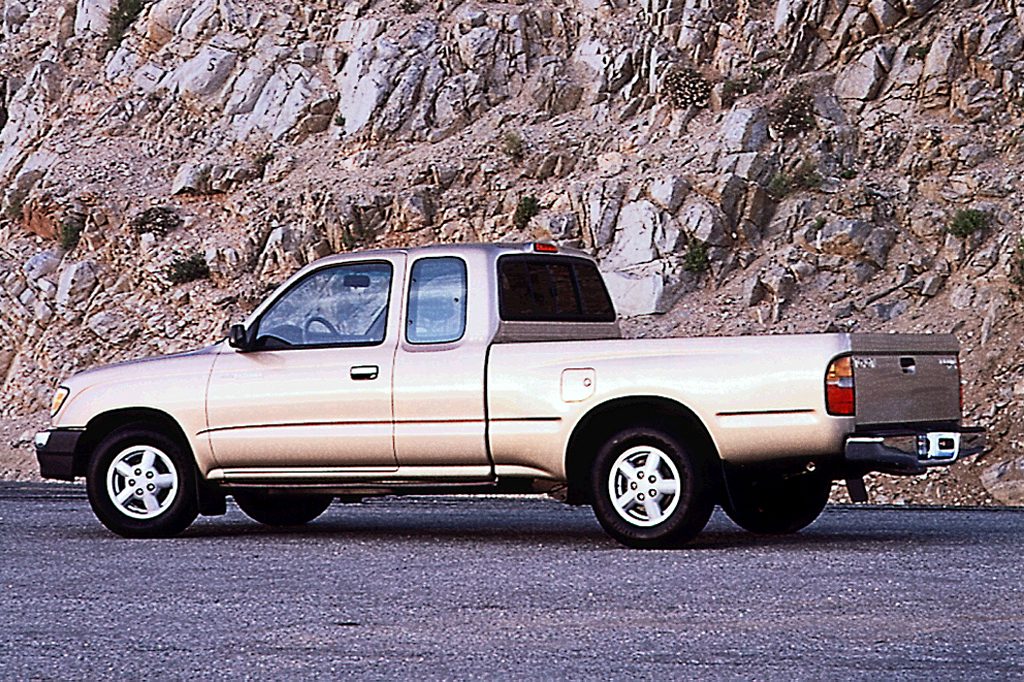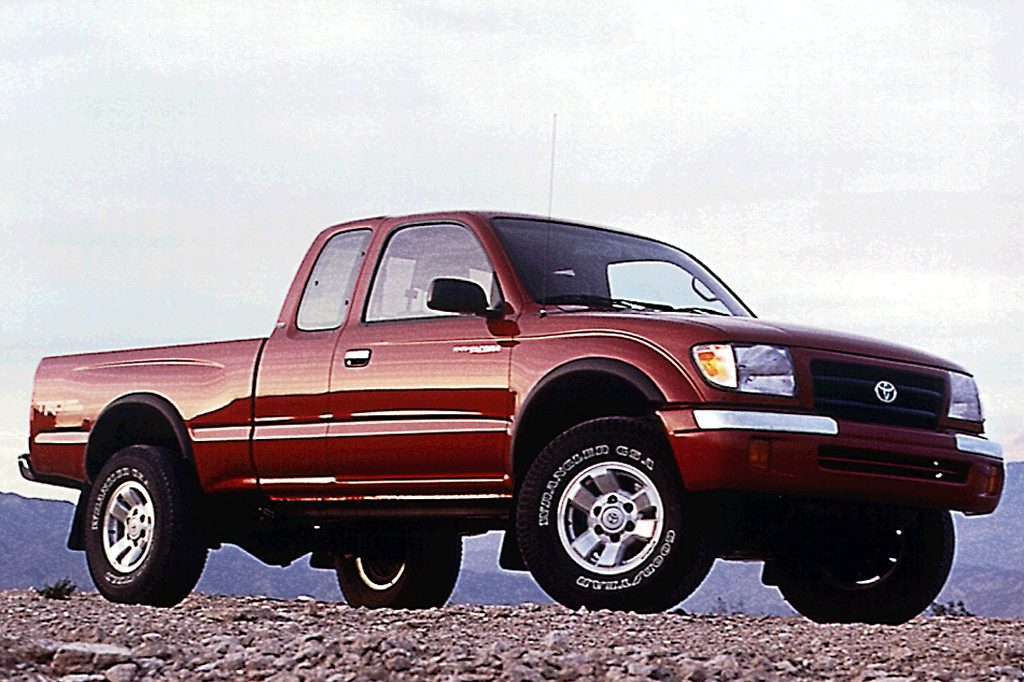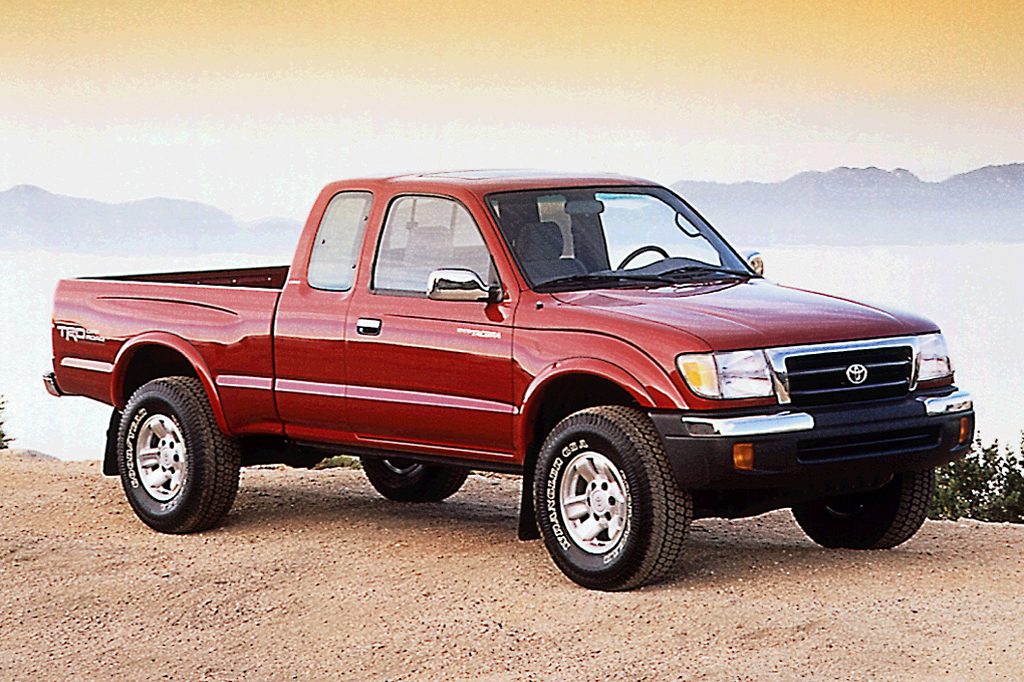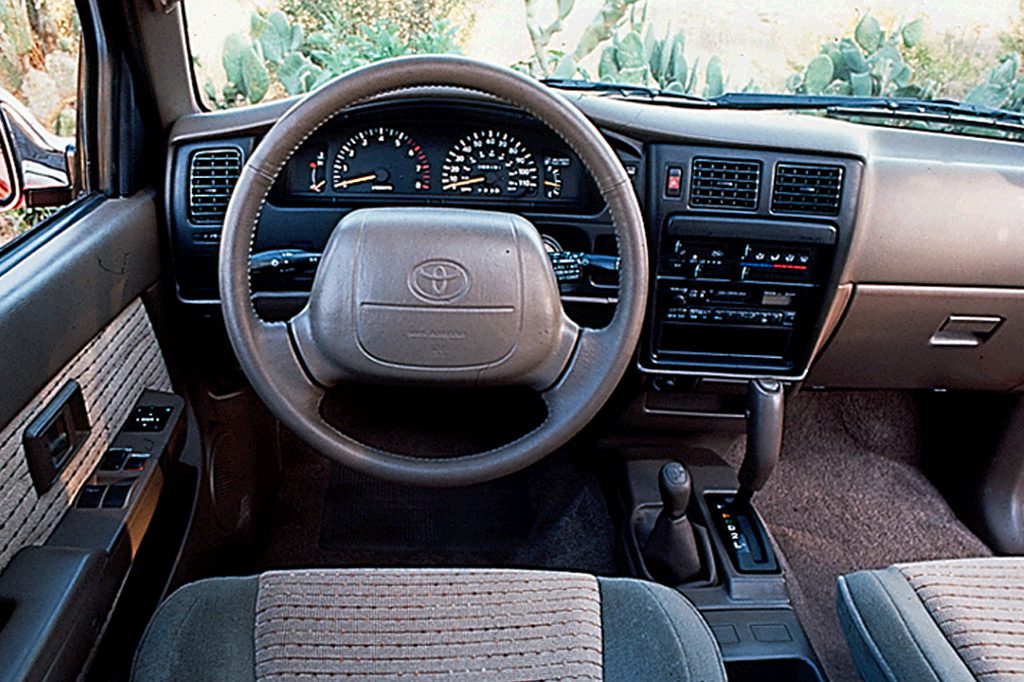| 2002 Toyota Tacoma |
Pricing Effective: 11/12/2001 |
| Model Pricing |
Retail Price |
Dealer Price |
Destination |
| 2WD Base regular cab 4-cylinder, manual |
$ 11,900 |
$ 11,008 |
$ 510 |
| 2WD Base regular cab 4-cylinder, automatic |
12,620 |
11,673 |
510 |
| 2WD PreRunner regular cab 4-cylinder, automatic |
13,890 |
12,721 |
510 |
| 2WD Xtracab extended cab 4-cylinder, manual |
14,540 |
13,303 |
510 |
| 2WD Xtracab extended cab 4-cylinder, automatic |
15,260 |
13,962 |
510 |
| 2WD PreRunner Xtracab extended cab 4-cylinder, automatic |
16,490 |
15,102 |
510 |
| 2WD PreRunner Xtracab extended cab V6, automatic |
18,340 |
16,798 |
510 |
| 2WD S-Runner Xtracab extended cab V6, manual |
18,060 |
16,524 |
510 |
| 2WD PreRunner Double Cab crew cab 4-cylinder, automatic |
18,110 |
16,588 |
510 |
| 2WD PreRunner Double Cab crew cab V6, automatic |
18,970 |
17,375 |
510 |
| 4WD Base regular cab 4-cylinder, manual |
16,310 |
14,760 |
510 |
| 4WD regular cab 4-cylinder, automatic |
17,210 |
15,575 |
510 |
| 4WD Xtracab extended cab 4-cylinder, manual |
18,430 |
16,678 |
510 |
| 4WD Xtracab extended cab 4-cylinder, automatic |
19,330 |
17,492 |
510 |
| 4WD Xtracab extended cab V6, manual |
19,520 |
17,665 |
510 |
| 4WD Xtracab extended cab V6, automatic |
20,420 |
18,479 |
510 |
| 4WD Double Cab crew cab V6, automatic |
22,120 |
20,018 |
510 |
| Price Note: Prices are for vehicles distributed by Toyota Motor Sales, U.S.A., Inc. The dealer invoice and destination charge may be higher in areas served by independent distributors. |
| Standard Equipment |
| Base regular cab : 2.4-liter dohc 4-cylinder engine, 5-speed manual or 4-speed automatic transmission, dual front airbags, power steering, cloth upholstery, bench seat, cupholders, AM/FM radio, intermittent wipers, carpeting, painted front bumper, full-size spare tire, 205/75R15 tires, 4WD adds: 4-wheel drive, 2.7-liter dohc 4-cylinder engine, 2-speed transfer case, manual locking hubs, painted rear bumper, mud guards, front tow hooks, skid plates, raised suspension, 225/75R15 tires |
| Base Xtracab adds: split bench seat, rear jump seats, AM/FM/cassette, painted rear bumper, 4WD adds: 4-wheel drive, 2.7-liter dohc 4-cylinder engine (4-cylinder), 3.4-liter dohc engine (V6), 2-speed transfer case, manual locking hubs, mud guards, front tow hooks, skid plates, raised suspension, 225/75R15 tires |
| PreRunner regular cab/Xtracab 4-cylinder adds to Base regular cab/Xtracab: 2.7-liter dohc 4-cylinder engine, 4-speed automatic transmission, painted rear bumper, raised suspension, 225/75R15 tires |
| PreRunner Xtracab V6 adds: 3.4-liter dohc V6 engine, air conditioning |
| S-Runner Xtracab adds: 5-speed manual transmission, tilt leather-wrapped steering wheel, front bucket seats w/power driver-seat lumbar support, tachometer, variable-intermittent wipers, color-keyed bumpers, lowered sport suspension, 235/55R16 tires, alloy wheels, (Deletes air conditioning) |
| PreRunner Double Cab adds to PreRunner Xtracab 4-cylinder: 2.7-liter dohc 4-cylinder or 3.4-liter dohc V6 engine, tilt steering wheel, front bucket seats, center console, split folding rear seat, front-hinged rear doors, variable-intermittent wipers |
| 4WD Double Cab adds: 3.4-liter dohc V6 engine, 4-wheel drive, 2-speed transfer case, manual locking hubs, mud guards, front tow hooks, skid plates |
| Optional Equipment |
| Option Note: Postproduction options also available. |
| Major Packages |
| Option |
Avail. |
Retail |
Dealer |
| Chrome SR5 Pkg. LX |
2WD Base regular cab |
$1730 |
$1557 |
| Chrome SR5 Pkg. LX |
4WD Base regular cab, PreRunner regular cab |
1310 |
1179 |
| Chrome SR5 Pkg. LX |
Base Xtracab, PreRunner Xtracab 4-cylinder |
1180 |
1062 |
| Chrome SR5 Pkg. LX |
PreRunner Xtracab V6 |
195 |
175 |
| Chrome SR5 Pkg. LX |
Double Cab |
935 |
842 |
| Air conditioning (Base, PreRunner 4-cylinder), tilt steering wheel, AM/FM/cassette/CD player, digital clock, tachometer, variable-intermittent wipers (regular cab), dual visor mirrors, visor extensions, chrome bumper and grille. Requires optional wheels or TRD Off-Road Pkg. |
| Color-Keyed SR5 Pkg. IX |
4WD regular cab, PreRunner regular cab |
1270 |
1145 |
| Color-Keyed SR5 Pkg. IX |
4WD Xtracab, PreRunner Xtracab 4-cylinder |
1140 |
1028 |
| Color-Keyed SR5 Pkg. IX |
PreRunner Xtracab V6 |
155 |
141 |
| Color-Keyed SR5 Pkg. IX |
Double Cab |
910 |
821 |
| Air conditioning (Base, PreRunner 4-cylinder), tilt steering wheel, AM/FM/cassette/CD player, digital clock, tachometer, variable-intermittent wipers (regular cab), dual visor mirrors, visor extensions, color-keyed bumper and grille. Requires optional wheels or TRD Off-Road Pkg. |
| Color-Keyed SR5 Pkg. 2 QX |
2WD Base regular cab |
1670 |
1503 |
| Color-Keyed SR5 Pkg. 2 QX |
4WD Base regular cab, PreRunner regular cab |
1290 |
1161 |
| Color-Keyed SR5 Pkg. 2 QX |
2WD Xtracab |
1120 |
1008 |
| Color-Keyed SR5 Pkg. 2 QX |
4WD Xtracab, PreRunner Xtracab 4-cylinder |
1160 |
1044 |
| Color-Keyed SR5 Pkg. 2 QX |
PreRunner Xtracab V6 |
175 |
157 |
| Color-Keyed SR5 Pkg. 2 QX |
Double Cab |
930 |
837 |
| Color-Keyed SR5 Pkg. IX plus color-keyed outside mirrors. Requires optional wheels or TRD Off-Road Pkg. |
| Sports Pkg. |
S-Runner |
1525 |
1370 |
| Air conditioning, power windows and door locks, AM/FM/cassette/CD player, digital clock, cloth door-trim panels, glovebox light, passenger-side visor mirror, sliding rear window. |
| Enhancement Pkg. |
2WD Base regular cab |
875 |
788 |
| Enhancement Pkg. |
4WD Base regular cab, PreRunner regular cab |
665 |
599 |
| Enhancement Pkg. |
2WD Base Xtracab 4-cylinder |
795 |
716 |
| Air conditioning, AM/FM/cassette (regular cab), painted rear bumper (2WD Base regular cab), 205/75R15 tires (2WD Base), special wheels (2WD Base). |
| Limited Pkg. |
4WD Xtracab V6 |
3625 |
2908 |
| Limited Pkg. |
Double Cab V6 |
3520 |
2811 |
| Air conditioning, tilt steering wheel (Xtracab), leather-wrapped steering wheel, cruise control, sport bucket seats, chrome power mirrors, power windows and door locks, AM/FM/cassette/CD player, digital clock, tachometer, passenger-side visor mirror, color-keyed bumpers and grille, 265/70R16 tires. Requires alloy wheels or TRD Off-Road Pkg. |
| TRD Off-Road Pkg. |
4WD Base Xtracab manual, PreRunner V6 |
1380 |
1113 |
| TRD Off-Road Pkg. |
PreRunner Xtracab 4-cylinder |
1040 |
832 |
| TRD Off-Road Pkg. |
Double Cab V6 |
1170 |
945 |
| TRD Off-Road Pkg. |
Double Cab 4-cylinder |
830 |
664 |
| Off-road suspension, limited-slip rear differential, black overfenders, rear console (PreRunner), 265/70R16 tires, alloy wheels (PreRunner). Requires SR5 Pkg. or bucket seats, Power Pkg., and tachometer. |
| Power Pkg. PO |
2WD Base regular cab |
525 |
420 |
| Power Pkg. PO |
2WD Base Xtracab |
565 |
452 |
| Power windows and door locks, cloth door trim, glovebox light. |
| Power Pkg. PP |
4WD regular cab, PreRunner regular cab |
655 |
524 |
| Power Pkg. PP |
4WD Base Xtracab, PreRunner Xtracab |
695 |
556 |
| Power Pkg. PP |
Double Cab |
825 |
660 |
| Power Pkg. PO plus power mirrors. |
| Convenience Pkg. |
Base Xtracab, S-Runner |
1100 |
880 |
| Convenience Pkg. |
4WD Base Xtracab, PreRunner Xtracab, |
1230 |
984 |
| Convenience Pkg. |
Double Cab |
1420 |
1136 |
| Power Pkg. PP plus cruise control, sliding rear window, rear privacy glass. |
| Stepside Pkg. |
regular cab, Xtracab |
310 |
279 |
| Stepside bed, color-keyed rear-bumper end caps and front-end post covers. Base PreRunner require SR5 Pkg. NA w/bed extender, bedliner, tonneau cover. |
| All Weather Guard Pkg. |
4WD |
75 |
63 |
| Heavy-duty starter, larger windshield washer tank. |
| Powertrain |
| Option |
Avail. |
Retail |
Dealer |
| Limited-slip rear differential |
4WD, PreRunner V6 |
340 |
281 |
| NA 4WD 4-cylinder w/automatic, regular cab. Requires tachometer, optional wheels or SR5/Limited Pkg. |
| 4WD selector switch |
4WD Xtracab V6, 4WD Double Cab |
135 |
111 |
| Includes automatic locking front hubs. Requires Power Pkg. or Limited Pkg. |
| Safety |
| Option |
Avail. |
Retail |
Dealer |
| Antilock brakes |
|
300 |
258 |
| Requires Power Pkg. or Limited Pkg. |
| Daytime running lights |
|
40 |
32 |
| Comfort & Convenience Features |
| Option |
Avail. |
Retail |
Dealer |
| Air conditioning |
|
985 |
788 |
| Std. PreRunner Xtracab V6. |
| Tilt steering wheel |
regular cab, Base Xtracab, PreRunner Xtracab |
245 |
209 |
| Includes variable-intermittent wipers. |
| Cruise control |
|
250 |
200 |
| Tachometer |
4WD Base, PreRunner, Double Cab |
95 |
76 |
| Digital clock |
regular cab, Xtracab |
82 |
50 |
| Manual pop-up sunroof |
Xtracab, 4WD Double Cab |
400 |
320 |
| Requires Power Pkg. or Limited Pkg. |
| AM/FM/cassette |
regular cab |
130 |
98 |
| CD player |
Double Cab |
275 |
194 |
| AM/FM/cassette/CD player |
regular cab |
330 |
248 |
| Bucket seats |
2WD Base regular cab |
315 |
252 |
| Bucket seats |
PreRunner regular cab |
325 |
260 |
| Bucket seats |
Base Xtracab |
65 |
52 |
| Bucket seats |
PreRunner Xtracab |
75 |
60 |
| Includes center console. 4WD Xtracab requires Limited Pkg. |
| Security System |
|
499 |
299 |
| Remote keyless entry, theft-deterrent system. Requires power door locks. |
| Floormats |
regular cab |
66 |
39 |
| Floormats |
XtraCab, Double Cab |
76 |
46 |
| Appearance and Miscellaneous |
| Option |
Avail. |
Retail |
Dealer |
| Bed extender |
|
279 |
167 |
| Tonneau cover |
|
350 |
229 |
| Bed liner |
|
299 |
160 |
| Tubular side steps |
regular cab |
409 |
265 |
| Tubular side steps |
Xtracab |
419 |
275 |
| Tubular side steps |
Double Cab |
469 |
305 |
| Running boards |
Double Cab |
315 |
252 |
| Chrome rear bumper |
2WD regular cab |
299 |
179 |
| Painted deluxe rear bumper |
2WD regular cab |
219 |
137 |
| Painted rear bumper |
2WD regular cab |
150 |
120 |
| Sliding rear window |
regular cab |
160 |
128 |
| Sliding rear window |
Xtracab |
285 |
228 |
| Sliding rear window |
Double Cab |
345 |
276 |
| Xtracab, Double Cab include privacy glass. |
| Mud guards |
2WD Base/PreRunner |
80 |
50 |
| Special Purpose, Wheels and Tires |
| Option |
Avail. |
Retail |
Dealer |
| Class II tow-hitch receiver |
|
359 |
259 |
| Class II tow-hitch receiver w/5000 pound tow pkg. |
|
499 |
389 |
| Styled steel wheels ST |
2WD Base, S-Runner |
110 |
88 |
| Styled steel wheels ST |
4WD regular cab/Xtracab, PreRunner regular cab/Xtracab |
570 |
456 |
| Styled steel wheels ST |
Double Cab |
360 |
288 |
| 4WD, PreRunner, include 265/70R16 tires, overfenders. |
| Chrome wheels CW |
4WD regular cab/Xtracab, PreRunner regular cab/Xtracab |
790 |
632 |
| Chrome wheels CW |
Double Cab |
580 |
464 |
| Includes 265/70R16 tires, overfenders. |
| Alloy wheels AW |
2WD Base, S-Runner |
1005 |
804 |
| Includes 235/55R16 tires. |
| Alloy wheels AA |
4WD Base regular cab/Xtracab, PreRunner regular cab/Xtracab |
970 |
776 |
| Alloy wheels AA |
Double Cab |
760 |
608 |
| Includes 265/70R16 tires, overfenders. |





